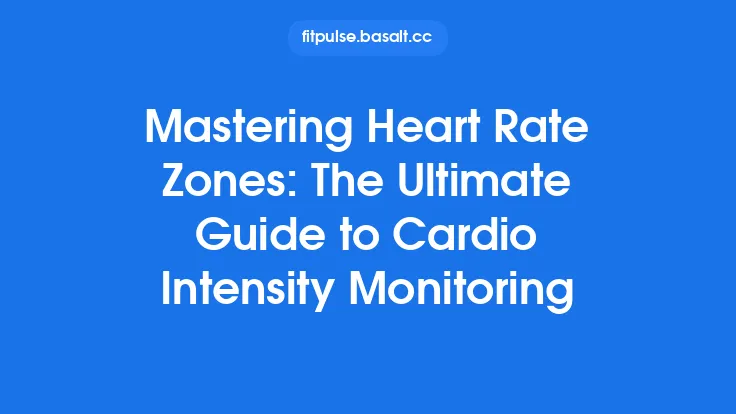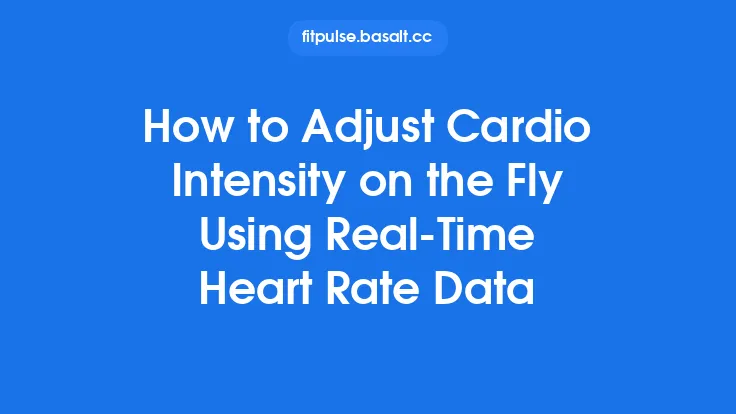Active recovery is a cornerstone of any well‑rounded training program, yet many athletes overlook the precision that heart‑rate monitoring can bring to these low‑intensity sessions. By anchoring recovery work to specific heart‑rate zones, you can ensure that the body receives just enough stimulus to promote circulation, nutrient delivery, and waste removal without tipping into the stress of a true training load. This approach transforms “easy” days from vague, feel‑good activities into data‑driven sessions that complement your overall periodization strategy.
Understanding the Physiological Basis of Heart‑Rate Zones
Heart‑rate zones are not arbitrary numbers; they reflect distinct metabolic and autonomic states:
| Zone | Approx. % of Max HR | Primary Energy System | Autonomic Balance |
|---|---|---|---|
| Zone 1 | 50‑60 % | Fat oxidation, basal metabolism | Parasympathetic dominance |
| Zone 2 | 60‑70 % | Aerobic glycolysis, mixed fuel | Balanced sympathetic‑parasympathetic |
| Zone 3 | 70‑80 % | Upper‑end aerobic, lactate threshold approaching | Mild sympathetic activation |
| Zone 4 | 80‑90 % | High‑intensity aerobic, lactate accumulation | Predominantly sympathetic |
| Zone 5 | 90‑100 % | Anaerobic, phosphagen system | Maximal sympathetic drive |
Active recovery should ideally sit in Zone 1 or the lower end of Zone 2. In these ranges, the cardiovascular system works hard enough to increase blood flow and shear stress on the endothelium—key drivers of nitric‑oxide production and capillary recruitment—while the nervous system remains largely in a restorative mode. Pushing into higher zones can inadvertently add training stress, delay recovery, and increase the risk of overreaching.
Determining Your Personal Heart‑Rate Zones
Accurate zones start with a reliable estimate of maximal heart rate (HRmax). While the classic “220 – age” formula is convenient, it can be off by ±10‑15 bpm for many individuals. Consider one of the following methods for a more precise baseline:
- Field Test (20‑Minute Time Trial)
- Warm up for 10 minutes at an easy pace.
- Perform a 20‑minute effort that feels “hard but sustainable.”
- Record the average heart rate over the final 15 minutes; multiply by 0.95 to approximate HRmax.
- Laboratory Graded Exercise Test (GXT)
- A treadmill or cycle ergometer protocol with incremental workload increases until volitional exhaustion.
- Direct measurement of HRmax and ventilatory thresholds, which can be used to fine‑tune zones.
- Wearable‑Based Algorithms
- Modern chest‑strap or optical sensors often incorporate proprietary models that adjust HRmax based on activity history and recovery trends. Use these as a supplemental check rather than the sole source.
Once HRmax is established, calculate the numeric boundaries for Zones 1 and 2. For example, a 30‑year‑old athlete with an HRmax of 190 bpm would have:
- Zone 1: 95‑114 bpm (50‑60 % HRmax)
- Zone 2 (lower half): 115‑133 bpm (60‑70 % HRmax)
Structuring an Active‑Recovery Session Around Heart‑Rate Zones
A typical active‑recovery workout can be broken into three phases: Warm‑up, Zone‑targeted work, and Cool‑down. The goal is to keep the majority of the session within the prescribed zone, using brief excursions above it only when necessary to reset the heart rate.
| Phase | Duration | Target HR | Practical Tips |
|---|---|---|---|
| Warm‑up | 5‑10 min | 50‑55 % HRmax (Zone 1) | Light movement (e.g., easy pedaling, gentle rowing) to gradually raise core temperature. |
| Zone‑targeted work | 20‑40 min | 55‑70 % HRmax (Zone 1‑low Zone 2) | Maintain a steady state; if HR spikes above 75 % HRmax, reduce intensity or pause briefly. |
| Cool‑down | 5‑10 min | 45‑55 % HRmax (Zone 1) | Gradually lower effort; focus on deep, rhythmic breathing to stimulate parasympathetic re‑activation. |
Key considerations:
- Avoid “drift.” Even at low intensities, heart rate can creep upward due to dehydration, heat, or cumulative fatigue. Periodically glance at the monitor and adjust cadence or resistance accordingly.
- Use “HR bands” rather than a single number. Allow a ±3‑5 bpm window to accommodate natural variability.
- Incorporate micro‑breaks. A 30‑second pause every 5‑10 minutes can help reset the heart rate and prevent inadvertent zone creep.
Leveraging Heart‑Rate Variability (HRV) to Fine‑Tune Zone Selection
While HRV is a separate metric, it can inform the placement of your recovery zones on a day‑to‑day basis. A higher resting HRV (indicative of a well‑recovered autonomic state) may allow you to push the upper bound of Zone 2 slightly higher (e.g., 72 % HRmax) without compromising recovery. Conversely, a depressed HRV suggests staying closer to the lower end of Zone 1.
Practical workflow:
- Morning HRV assessment (e.g., 5‑minute supine measurement).
- Compare to baseline (your 7‑day rolling average).
- Adjust active‑recovery zone:
- HRV ≥ baseline + 5 % → Upper Zone 2 (70 % HRmax).
- HRV ≈ baseline → Standard Zone 1‑low Zone 2.
- HRV ≤ baseline – 5 % → Strict Zone 1 (≤ 60 % HRmax).
This dynamic approach respects the day‑to‑day fluctuations in readiness while keeping the recovery stimulus appropriately calibrated.
Selecting the Right Monitoring Tools
Accuracy matters most when you are operating in a narrow heart‑rate band. Here are the most reliable options:
- Chest‑strap ECG sensors (e.g., Polar H10, Garmin HRM‑Pro). Provide ±1‑2 bpm accuracy and are less susceptible to motion artefacts.
- Arm‑band optical sensors (e.g., Scosche Rhythm+). Offer a good compromise between comfort and precision, especially for activities where a chest strap may be uncomfortable.
- Smartwatch optical sensors (e.g., Apple Watch, Fitbit). Convenient but can drift at low intensities; consider cross‑checking with a chest strap during the first few sessions.
Whichever device you choose, ensure it logs data in a format that can be exported for post‑session analysis (CSV, FIT, or similar). This enables you to review HR trends, identify drift, and refine future zone targets.
Common Pitfalls and How to Avoid Them
| Pitfall | Why It Happens | Remedy |
|---|---|---|
| Relying on perceived effort alone | Subjective feeling can be misleading, especially when fatigued. | Pair RPE with real‑time HR data; adjust intensity if HR exceeds target zone even if you “feel fine.” |
| Using a static HRmax across seasons | Fitness gains, aging, and training load can shift HRmax by 5‑10 bpm. | Re‑test HRmax every 8‑12 weeks or after a major training block. |
| Neglecting environmental factors | Heat, altitude, and dehydration raise HR at a given workload. | Monitor core temperature (or use a temperature‑adjusted HR correction factor) and stay hydrated; lower intensity if HR spikes unexpectedly. |
| Over‑extending the recovery window | Long sessions (>60 min) can accumulate enough volume to become a training stimulus. | Keep active‑recovery bouts under 45 minutes total, unless deliberately using a “recovery marathon” approach under professional supervision. |
| Ignoring post‑session HR trends | A failure to drop below baseline HR after recovery may signal insufficient rest. | Track post‑exercise HR for 5‑10 minutes; if it remains elevated, consider extending the cool‑down or adding a brief low‑intensity walk. |
Integrating Heart‑Rate‑Based Recovery into a Periodized Plan
Even though the focus here is on the mechanics of heart‑rate zones, it is useful to understand where these sessions sit within a broader training macro‑cycle:
- Macro‑phase (e.g., 12‑week block): Schedule 1‑2 active‑recovery days per week, each anchored to Zone 1‑low Zone 2.
- Mesocycle (e.g., 4‑week micro‑block): During high‑intensity weeks, tighten the upper bound to 60 % HRmax to ensure maximal parasympathetic recovery. In “recovery weeks,” you may allow the upper bound to creep to 70 % HRmax.
- Micro‑cycle (weekly): Use HRV or resting HR trends to decide whether a given day’s recovery session should be “strict” (Zone 1 only) or “relaxed” (low Zone 2).
By aligning heart‑rate‑guided recovery with the larger training architecture, you preserve the intended stimulus‑recovery balance and reduce the risk of cumulative fatigue.
Sample Data‑Driven Recovery Session (Illustrative)
| Time (min) | Activity | Target HR (bpm) | Notes |
|---|---|---|---|
| 0‑5 | Light warm‑up (e.g., easy pedaling) | 95‑105 | Gradual ramp‑up; watch for sudden spikes. |
| 5‑25 | Steady‑state low‑intensity work | 110‑120 (≈ 58 % HRmax) | Maintain consistent cadence; if HR > 125, reduce resistance. |
| 25‑30 | Micro‑break (stand, deep breaths) | 90‑100 | Allows HR to settle; check for drift. |
| 30‑45 | Continue steady‑state work | 110‑120 | Same guidelines as earlier block. |
| 45‑50 | Cool‑down (very easy movement) | 90‑100 | Focus on controlled exhalations to trigger parasympathetic tone. |
| 50‑55 | Post‑session HR check (supine) | < 80 (baseline) | If HR remains elevated, consider additional hydration or a brief stretch. |
The numbers above are illustrative; replace them with your individualized zone calculations.
Tracking Progress Over Time
To truly reap the benefits of heart‑rate‑guided recovery, maintain a simple log that captures:
- Date & Training Load of Prior Session (e.g., “Heavy leg day – 85 % HRmax for 45 min”).
- Recovery Session HR Data (average, max, drift percentage).
- Subjective Recovery Rating (1‑10 scale).
- Morning HRV (if available).
Over weeks, patterns will emerge: a consistent rise in average recovery HR may signal accumulating fatigue, prompting a “strict” recovery day or an extra rest day. Conversely, a stable or decreasing recovery HR alongside high HRV suggests the current recovery prescription is effective.
Final Thoughts
Heart‑rate zones transform active recovery from a vague “easy day” into a precise, measurable tool that supports adaptation while safeguarding against overtraining. By:
- Accurately establishing personal HRmax,
- Targeting the lower end of Zones 1 and 2,
- Monitoring drift and adjusting intensity in real time,
- Leveraging HRV to fine‑tune daily zone boundaries, and
- Embedding these sessions within a structured periodization framework,
you create a feedback loop where each recovery effort directly contributes to the next performance gain. The result is a training ecosystem where the body’s physiological signals guide the balance between stress and repair, leading to stronger, more resilient athletes over the long term.





